内科学教学课件:Nephrotic syndrome
合集下载
【医学PPT课件】肾病症候群

或更換姿勢 − 男性生殖器水腫應給予支托和保護 − 注意水腫皮膚的觀察,避免壓迫和磨損 − 定時量體重 − 低鹽飲食、限制水分
嬰幼兒疾病預防與處理
4
使用類固醇之護理 − 藥物造成月亮臉和水牛肩,需關心兒童身體心
像發展 − 注意服藥之正確性:飯後配合制酸劑 − 預防兒童感染疾病:服藥期間暫停接受疫苗注
射 − 切勿突然停藥,以免生生命危險 − 有感染症狀時應就醫
嬰幼兒疾病預防與處理
3
腎病症候群 (Nephrotic Syndrome)
全身水腫之護理 − 嚴重水腫宜臥床休息,每2小時協助兒童翻身
【医学PPT课件】腎病症候群
腎病症候群 (Nephrotic Syndrome)
病因與症狀
− 可能與自發性的細胞免疫系統異常有關 − 好發年齡:2~6歲學齡前兒童 − 男女罹病率:2:1 − 症狀:全身水腫或腹水;蛋白尿及低蛋
白血症;高膽固醇血症;少尿或無尿; 高血壓
嬰幼兒疾病預防與處理
2
腎病症候群 (Nephrotic Syndrome)
嬰幼兒疾病預防與處理
4
使用類固醇之護理 − 藥物造成月亮臉和水牛肩,需關心兒童身體心
像發展 − 注意服藥之正確性:飯後配合制酸劑 − 預防兒童感染疾病:服藥期間暫停接受疫苗注
射 − 切勿突然停藥,以免生生命危險 − 有感染症狀時應就醫
嬰幼兒疾病預防與處理
3
腎病症候群 (Nephrotic Syndrome)
全身水腫之護理 − 嚴重水腫宜臥床休息,每2小時協助兒童翻身
【医学PPT课件】腎病症候群
腎病症候群 (Nephrotic Syndrome)
病因與症狀
− 可能與自發性的細胞免疫系統異常有關 − 好發年齡:2~6歲學齡前兒童 − 男女罹病率:2:1 − 症狀:全身水腫或腹水;蛋白尿及低蛋
白血症;高膽固醇血症;少尿或無尿; 高血壓
嬰幼兒疾病預防與處理
2
腎病症候群 (Nephrotic Syndrome)
肾病综合征NephroticSyndromePPT课件

VLDL
酶内
血
中等密度
含皮 量脂
脂
脂蛋白
蛋
分解及清除
尿丢失脂代谢 辅助物质
最近的观点
与脂蛋白脱脂及分解过程延缓有关
16
肾病综合征的常见病理类型
微小病变型肾病 系膜增生性肾小球肾炎 局灶性节段性肾小球硬化 膜性肾病 系膜毛细血管性肾小球肾炎
17
临床特征 (微小病变型肾病)
常见于儿童 (~80%) 表现为典型的肾病综合征 常无血尿、高血压和肾功能减退 90%病例对激素敏感 复发率高达60% 可演变为MsPGS FSGS
(局灶性节段性肾小球硬化)
光镜
肾小球成局灶、节段性硬化。 系膜基质增多,毛细血管闭塞,球囊粘连。 相应的肾小管萎缩,肾间质纤维化。
免疫荧光
IgM 和 C3 在受累节段呈团块状沉积
电镜
电子致密物积在肾小球硬化区 肾小球上皮细胞足突广泛融合
40
41
42
43
44
45
膜性肾病的临床特征
常见于中老年,男性多于女性; 起病隐匿,很少有前驱感染; 约80%表现为NS ,占我国原发性NS的25%~30%; 一般无肉眼血尿,~30%伴有镜下血尿; 早期常无高血压和肾功损害; 极易发生血栓、栓塞性并发症 肾静脉血栓发生率可高达40%~50%; 积极给与抗凝溶栓治疗; 本病进展缓慢,5~10年后逐渐出现肾功损害; 约20%-35%患者临床表现可自行缓解; 大部分患者经治疗可达临床缓解。
↓ Na+及水潴留
↓
水肿形成
Overfill mechamism
肾脏潴Na+(肾功能正常病人)
↓ 血浆容量↑
渗透压↓ 低蛋白血症
组织间液 水容量增 长>5kg
内科学课件23 Nephrotic syndrome
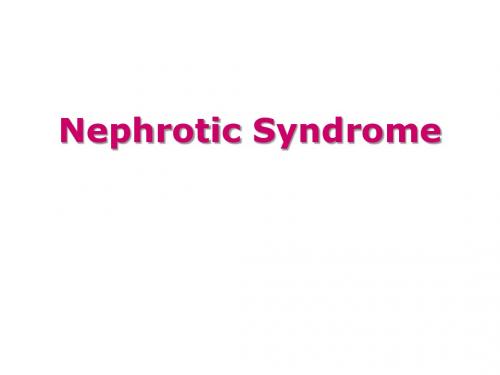
rning objectives
• Clinical manifestation, pathology and treatment of nephrotic syndrome • Pathophysiology of nephrotic syndrome
• Complications of nephrotic syndrome
Figure 1.
Nephrotic edema.
Figure 2. Nephrotic edema.
Diagnosis:
Pro ++++
• Proteinuria: >3.5g/d • Hypoalbuminemia: SAlb <30g/L • Edema • Hyperlipidemia
Let’s go back to Mr. O
• • • • • Urine protein ++++, RBC (-), WBC (-) 24h urinary protein 7.8g Normal kidney and Liver function Serum albumin 20g/L Total cholesterol 10.2mmol/L
Mr. O was diagnosed with nephrotic syndrome
Proteinuria (albuminuria)
Figure 3.
Hypoalbuminemia
• • • • • • • Albumin Immunoglobulins Metal binding proteins Erythropoietin Transferrin Complement deficiency Coagulation components
• Clinical manifestation, pathology and treatment of nephrotic syndrome • Pathophysiology of nephrotic syndrome
• Complications of nephrotic syndrome
Figure 1.
Nephrotic edema.
Figure 2. Nephrotic edema.
Diagnosis:
Pro ++++
• Proteinuria: >3.5g/d • Hypoalbuminemia: SAlb <30g/L • Edema • Hyperlipidemia
Let’s go back to Mr. O
• • • • • Urine protein ++++, RBC (-), WBC (-) 24h urinary protein 7.8g Normal kidney and Liver function Serum albumin 20g/L Total cholesterol 10.2mmol/L
Mr. O was diagnosed with nephrotic syndrome
Proteinuria (albuminuria)
Figure 3.
Hypoalbuminemia
• • • • • • • Albumin Immunoglobulins Metal binding proteins Erythropoietin Transferrin Complement deficiency Coagulation components
Nephrotic Syndrome -精品医学课件
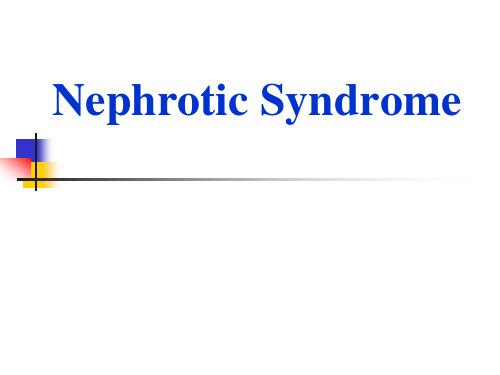
Hypercoagulability and Thrombosis
Causes Coagulation factors↑ Platelet aggregation↑ Antithrombin Ⅲ↓ Hyperlipidemia Diuretic therapy Steroid therapy
Laboratory Tests
Urine
Urinalysis, 24h urinary protein, Urinary Pro/Cr
Serum
Albumin, cholesterol, triglyceride IgG, IgA, IgM Sodium, potassium,calcium Coagulation function BUN, Cr
Classification
Simple type Nephritic type
Classification
Nephritic type
Hematuria Hypertension Renal function insufficient Hypocomplementemia
Differential Diagnosis
Aperture Barrier
slit diaphragm
Endothelium
Charge-Selective Barrier
Endothelium
Etiology
肾小球毛细血管壁结构或电荷的变化可导致蛋 白尿。
高选择性蛋白尿 低选择性蛋白尿
病因及发病机制目前尚不明确
局部免疫病理过程可损伤滤过膜正常屏障作用 T淋巴细胞异常 具有遗传基础
Classification
Nephrotic Syndrome-精品医学课件
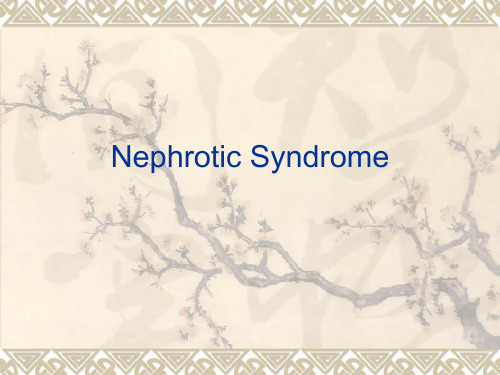
lowing treatment
prognosis
❖ Pathotype ❖ Clinical feature ❖ Complication
❖ Thank you for your attention!
53
Clinical features ❖ Young and middle-aged men ❖ Infection, hematuria, Progress fast ❖ Treatment is difficult
❖ Membranous Nephropathy
Light microscope “spikes” Immunofluorescence IgG and C3 deposit Electron microscope electron-dense deposits and
Immunodepressant
❖ CTX ❖ Chlormethine ❖ CSA ❖ MMF ❖ FK506
Prevention complication
❖ Infections----antibiotics ❖ Thrombosis----anticoagulation ❖ acute renal failure----diuresis, dialysis ❖ Protein and lipid metabolic disturbance----reduce urinary protein ,Lipid-
pathogen
❖ Secondary
Systemic lupus erythematosus, SLE Diabetic nephropathy, DN Renal amyloidosis Allergic purpura Drug Tumor ...
prognosis
❖ Pathotype ❖ Clinical feature ❖ Complication
❖ Thank you for your attention!
53
Clinical features ❖ Young and middle-aged men ❖ Infection, hematuria, Progress fast ❖ Treatment is difficult
❖ Membranous Nephropathy
Light microscope “spikes” Immunofluorescence IgG and C3 deposit Electron microscope electron-dense deposits and
Immunodepressant
❖ CTX ❖ Chlormethine ❖ CSA ❖ MMF ❖ FK506
Prevention complication
❖ Infections----antibiotics ❖ Thrombosis----anticoagulation ❖ acute renal failure----diuresis, dialysis ❖ Protein and lipid metabolic disturbance----reduce urinary protein ,Lipid-
pathogen
❖ Secondary
Systemic lupus erythematosus, SLE Diabetic nephropathy, DN Renal amyloidosis Allergic purpura Drug Tumor ...
内科学课件:肾病综合征
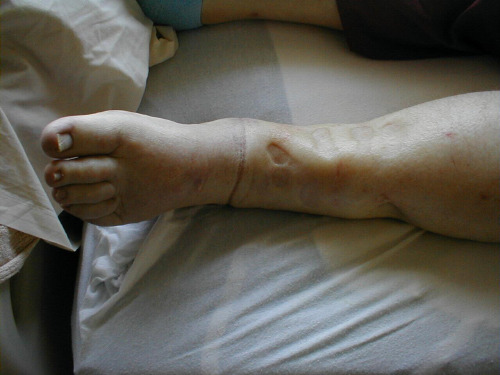
systemic lupus erythenlatosus nephritis,SLEN
Henoch-Schonlein purpura nephritis,HSPN
hepatitis b virus associated nephritis
中老年
membranous nephropathy(MN)
细血管壁 △电镜 系膜区、有时在内皮下电子致密物
图:5-4-2系膜增生性肾小球肾炎
左:正常肾小球
右:病变肾小球
1.上皮细胞 2.基底膜 3.内皮细胞 4.系膜细胞
5.免疫复合物
系膜增生型
•系膜增殖性肾小球肾炎。系膜细胞和基质增生
临床表现
好发于青少年,50%有前驱症状(上呼吸道感染),发病较 多样化→急性肾炎综合征或隐匿起病
→NS30%镜下血尿,一般无肉眼血尿 约50%患者5-10年后才出现高血压与肾功能 损害 极易发生血栓、栓塞,肾V血栓高达40-50%
治疗和预后
治疗 I期膜性肾病激素加CTX治疗可有效 II、III期病变疗效差,易产生感染及高凝 预后 蛋白尿程度是判断预后指标: 蛋白尿越多→预后差;蛋白尿<3.5g → 预后较好 出现高血压、肾功能↓、严重小管间质病变→预后差
肾病综合征
(Nephrotic Syndrome)
讲授主要内容
概述 病因 病理生理 病理类型及临床表 现、预后 并发症 诊断和鉴别诊断 治疗 小结
概述
是各种肾脏疾病,主要是肾小球疾病所致的临床综
合征,特征性的临床表现:
1. 大量蛋白尿(≥3.5g/d) 2. 低血浆白蛋白(Alb<30g/L)
肾小球上皮细胞足突融合
图:5-4-1微小病变型肾病
左:正常肾小球
Henoch-Schonlein purpura nephritis,HSPN
hepatitis b virus associated nephritis
中老年
membranous nephropathy(MN)
细血管壁 △电镜 系膜区、有时在内皮下电子致密物
图:5-4-2系膜增生性肾小球肾炎
左:正常肾小球
右:病变肾小球
1.上皮细胞 2.基底膜 3.内皮细胞 4.系膜细胞
5.免疫复合物
系膜增生型
•系膜增殖性肾小球肾炎。系膜细胞和基质增生
临床表现
好发于青少年,50%有前驱症状(上呼吸道感染),发病较 多样化→急性肾炎综合征或隐匿起病
→NS30%镜下血尿,一般无肉眼血尿 约50%患者5-10年后才出现高血压与肾功能 损害 极易发生血栓、栓塞,肾V血栓高达40-50%
治疗和预后
治疗 I期膜性肾病激素加CTX治疗可有效 II、III期病变疗效差,易产生感染及高凝 预后 蛋白尿程度是判断预后指标: 蛋白尿越多→预后差;蛋白尿<3.5g → 预后较好 出现高血压、肾功能↓、严重小管间质病变→预后差
肾病综合征
(Nephrotic Syndrome)
讲授主要内容
概述 病因 病理生理 病理类型及临床表 现、预后 并发症 诊断和鉴别诊断 治疗 小结
概述
是各种肾脏疾病,主要是肾小球疾病所致的临床综
合征,特征性的临床表现:
1. 大量蛋白尿(≥3.5g/d) 2. 低血浆白蛋白(Alb<30g/L)
肾小球上皮细胞足突融合
图:5-4-1微小病变型肾病
左:正常肾小球
内科学教学课件:肾病综合征
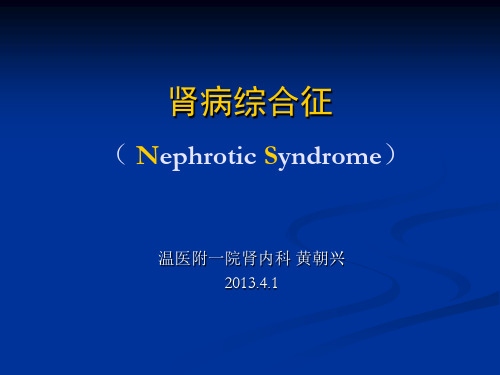
血浆蛋白的通透性↑ 原尿中蛋白含量增多
大量蛋白尿
肾病综合征由足细胞病引起
NS:低蛋白血症的发生机制
✓ 大量蛋白尿→肝代偿性合成白蛋白不足,白 蛋白在肾小管分解增加 →低蛋白血症发生
✓ 食物中蛋白质摄入不足,吸收不良→低蛋白 血症加重
✓ 糖皮质激素使用→蛋白质分解增加→低蛋 白血症加重
NS:水肿的发生机制
例描述 • Domenico Cotugno(1736-1820)—De Ischiade Nerchiade Nervosa
commentarius(1770)-发现蛋白尿 • Richard bright-进行了病例报道—1827;John Bostock (1773-1846)
and Sir robert christison of Edinburgh(1797-1882)进行了相同的工作 • 1830_被详细描述
DN, diabetic
nephropathy
我国NS病因和发病年龄
分 类
儿童
青少年
原 微小病变型肾病 系膜增生性肾小球肾炎
发
系膜毛细血管性肾小球 肾炎
性
局灶节段性肾小球硬化
过敏性紫癜性肾 系统性红斑狼疮
继
炎 乙肝病毒相关性 过敏性紫癜性肾炎
发
肾小球肾炎 系统性红斑狼疮 乙肝病毒相关性肾小球
肾炎
性
古希腊名医希坡克拉底
• Hippocrates(公元前460-370)发现水肿的患者存在气泡尿 • Cornelius Roelans(1450-1525)-Liber de aegritudinibus infantium.于1984
首先描述了全身水肿症状 • TheodoreZwinger Шof Basel(1658-1724)—Paediatreia Practica(1722)病
大量蛋白尿
肾病综合征由足细胞病引起
NS:低蛋白血症的发生机制
✓ 大量蛋白尿→肝代偿性合成白蛋白不足,白 蛋白在肾小管分解增加 →低蛋白血症发生
✓ 食物中蛋白质摄入不足,吸收不良→低蛋白 血症加重
✓ 糖皮质激素使用→蛋白质分解增加→低蛋 白血症加重
NS:水肿的发生机制
例描述 • Domenico Cotugno(1736-1820)—De Ischiade Nerchiade Nervosa
commentarius(1770)-发现蛋白尿 • Richard bright-进行了病例报道—1827;John Bostock (1773-1846)
and Sir robert christison of Edinburgh(1797-1882)进行了相同的工作 • 1830_被详细描述
DN, diabetic
nephropathy
我国NS病因和发病年龄
分 类
儿童
青少年
原 微小病变型肾病 系膜增生性肾小球肾炎
发
系膜毛细血管性肾小球 肾炎
性
局灶节段性肾小球硬化
过敏性紫癜性肾 系统性红斑狼疮
继
炎 乙肝病毒相关性 过敏性紫癜性肾炎
发
肾小球肾炎 系统性红斑狼疮 乙肝病毒相关性肾小球
肾炎
性
古希腊名医希坡克拉底
• Hippocrates(公元前460-370)发现水肿的患者存在气泡尿 • Cornelius Roelans(1450-1525)-Liber de aegritudinibus infantium.于1984
首先描述了全身水肿症状 • TheodoreZwinger Шof Basel(1658-1724)—Paediatreia Practica(1722)病
肾病综合征诊治课件PPT
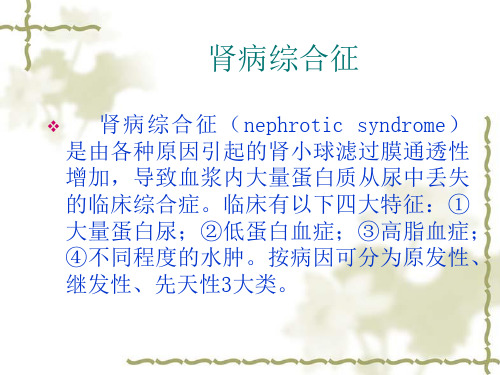
❖尚不清楚。目前认为: ❖1、肾小球毛细血管壁结构或电化学的改变可导致蛋白
尿。 ❖2、与T细胞免疫功能紊乱有关。CD4/CD8 、IL-1、6、
8和血管通透因子显著升高。 ❖3、非微小病变型内常见免疫球蛋白和或补体成分沉积,
局部免疫病理过程可损伤滤过膜的正常屏障作用而发 生蛋白尿。 ❖4、与遗传有关。
肾病综合征
❖ 肾病综合征(nephrotic syndrome) 是由各种原因引起的肾小球滤过膜通透性 增加,导致血浆内大量蛋白质从尿中丢失 的临床综合症。临床有以下四大特征:① 大量蛋白尿;②低蛋白血症;③高脂血症; ④不同程度的水肿。按病因可分为原发性、 继发性、先天性3大类。
一、病因及发病机制
MCN: effacement of epithelial foot process in EM
三、病理生理
❖1、蛋白尿(Proteinuria)
❖ 分子机械屏障受损
非选择性蛋白尿
❖ 静电屏障受损
选择性蛋白尿
❖新 进 展 : 近 来 研 究 发 现 “ 足 细 胞 分 子 ” nephrin 、CD2-AP、 podocin 、а-actinin-4
等是肾病综合征发生蛋白尿的关键分子。
❖2、低蛋白血症(hypoproteinemia) 或25g/l
❖3、高脂血症(hyperlipemia) ❖4、水肿(edema) ❖5、其它
白蛋白﹤30g/l
四、临床表现
❖ 主要是不同程度的水肿,为凹陷性水肿。血 压多数正常,少数患儿有高血压症状。
单纯型
二、病理
❖1、微小病变(MCD) 光镜下肾小球基本正常,或仅有 极轻微的系膜变化。电镜可见有典型上皮细胞肿胀, 足突融合,免疫荧光基本阴性。
尿。 ❖2、与T细胞免疫功能紊乱有关。CD4/CD8 、IL-1、6、
8和血管通透因子显著升高。 ❖3、非微小病变型内常见免疫球蛋白和或补体成分沉积,
局部免疫病理过程可损伤滤过膜的正常屏障作用而发 生蛋白尿。 ❖4、与遗传有关。
肾病综合征
❖ 肾病综合征(nephrotic syndrome) 是由各种原因引起的肾小球滤过膜通透性 增加,导致血浆内大量蛋白质从尿中丢失 的临床综合症。临床有以下四大特征:① 大量蛋白尿;②低蛋白血症;③高脂血症; ④不同程度的水肿。按病因可分为原发性、 继发性、先天性3大类。
一、病因及发病机制
MCN: effacement of epithelial foot process in EM
三、病理生理
❖1、蛋白尿(Proteinuria)
❖ 分子机械屏障受损
非选择性蛋白尿
❖ 静电屏障受损
选择性蛋白尿
❖新 进 展 : 近 来 研 究 发 现 “ 足 细 胞 分 子 ” nephrin 、CD2-AP、 podocin 、а-actinin-4
等是肾病综合征发生蛋白尿的关键分子。
❖2、低蛋白血症(hypoproteinemia) 或25g/l
❖3、高脂血症(hyperlipemia) ❖4、水肿(edema) ❖5、其它
白蛋白﹤30g/l
四、临床表现
❖ 主要是不同程度的水肿,为凹陷性水肿。血 压多数正常,少数患儿有高血压症状。
单纯型
二、病理
❖1、微小病变(MCD) 光镜下肾小球基本正常,或仅有 极轻微的系膜变化。电镜可见有典型上皮细胞肿胀, 足突融合,免疫荧光基本阴性。
内科学肾病综合征课件
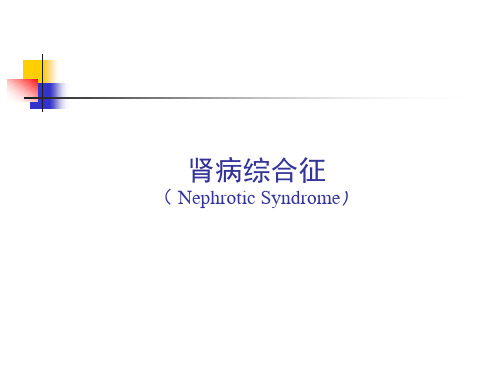
肾病综合征的预后
预后取决于以下因素: 病理类型 临床症状 并发症的存在
光镜
系膜细胞和基质弥漫重度增生,插入到GBM 和内皮细胞之间,形成“双轨征” (tram-tracks)
免疫荧光
IgG /C3呈颗粒状沉积在系膜区和毛细血管壁
电镜
内皮下和系膜区可见电子致密物沉积
临床特征 (系膜毛细血管性肾小球肾炎)
好发于青壮年,男性多于女性; 30%的患者有前驱感染; 约50%~60%表现为NS; 约30%表现为急性肾炎综合征; 少数表现为无症状性血尿/蛋白尿; 100%伴有血尿,少数为发作性肉眼血尿; 50%~70%病例的血清 C3持续降低; 肾功损害、高血压及贫血出现的早; 发病后10年约50%的病例进展至CRF。
系膜毛细血管性肾小球肾炎
疗效差,长期足量激素治疗可延缓部分儿童患者的 肾功能恶化
肾病综合征的抗凝治疗
血浆白蛋白低于20g/L 即应开始抗凝治疗; 肝素或低分子肝素/华法令或香豆素类药物; 抗凝的同时可辅以抗血小板药物; 发生血栓、栓塞者尽早给予溶栓治疗; 抗凝及溶栓治疗时均应避免药物过量导致出血。
病理 系膜毛细血管性肾小球肾炎 (MCGN)
病理 (膜性肾病)
光镜 肾小球基底膜增厚 上皮侧免疫复合物形成“钉突样”改变 肾小球内没有明显的细胞增殖
免疫荧光 IgG和C3呈细颗粒状沿GBM沉积
电镜 GBM上皮侧排列整齐的电子致密物
临床特征 (膜性肾病)
常见于中老年,男性多于女性; 起病隐匿,很少有前驱感染; 约80%表现为NS ,占我国原发性NS的25%~
血浆胶体渗透压,促进组织中水分回吸收并利尿。但应严 格掌握适应证
肾病综合征患者利尿治疗的原则: 不宜过快、过猛,以免造成有效血容量不足、加重血液高黏倾向,诱 发血栓、栓塞并发症
- 1、下载文档前请自行甄别文档内容的完整性,平台不提供额外的编辑、内容补充、找答案等附加服务。
- 2、"仅部分预览"的文档,不可在线预览部分如存在完整性等问题,可反馈申请退款(可完整预览的文档不适用该条件!)。
- 3、如文档侵犯您的权益,请联系客服反馈,我们会尽快为您处理(人工客服工作时间:9:00-18:30)。
• Treatment: 30%-50% of patients treat with glucocorticoids for 8 weeks. Up to70% respond when steroid therapy is prolonged for 3-4months. Mycophenolate mofetil is another option in resistant cases
【pathophysiology】
• Large amount of proteinuria:
molecular & charge barrier are damaged → glomerular proteinuria
• Changes of plasma protein:
①ALB synthesis↑<lose↑+ catabolism ↑; pro. intake↓≥ pro. in plasma↓
分 类
儿童
青少年
中老年
微小病变型肾病 系膜增生性肾小球肾炎 膜性肾病
原
发
系膜毛细血管性肾小球 肾炎
性
局灶节段性肾小球硬化
过敏性紫癜性肾 系统性红斑狼疮
炎
继
乙肝病毒相关性 过敏性紫癜性肾炎 肾小球肾炎
糖尿病肾病 肾淀粉样变性
发 系统性红斑狼疮 乙肝病毒相关性肾小球 骨髓瘤性肾病
肾炎
性
淋巴瘤或实体肿 瘤性肾病
• Hyperlipidemia: lipoprotein synthesis↑+ lipoprotein break up↓ → cholesterol, triglyceride↑
Pathological types
1.Minimal change disease (MCD) 2.Focal segmental glomerular sclerosis
【pathology & clinical features 】
• a characteristic fusion of epithelial foot processes
• Treatment: Spontaneous alleviate occurs in 30%-40% of patients; Sensitive to glucocortical hormone; MCD is a highly steroid-responsive and carries an excellent prognosis.
• 分型: 经典型 塌陷型 顶端型 细胞型 非特殊型
【pathology & clinical features】
• NS.80% patients have microscopic hematuria, 50% have hypertention, decreased renal function is present in 30%
※Chapter 4 Nephrotic syndrome
(NS)
Diagnosis standard:
1.Protein in urine>3.5g/d
2.Serum albumin<30g/l
a
4.Blood lipid rise Essentials of diagnosis include proteinuria
2.secondary~: purpura nephritis, hepatitis B virus related nephritis, lupus nephritis, diabetic nephropathy,
renal amyloidosis, myeloma nephropathy, lymphoma/noumenal tumor nephropathy, etc
Pictures of ← Minimal Change
Disease ↙↓
电镜观察 左:正常肾小球足突 右:肾小球足突广泛融合
【pathology & clinical features】
2.Focal segmental glomerular sclerosis (FSGS):
• Adolescence male
(FSGS) 3.Membranous nephropathy 4.Mesangial proliferative
glomerulaonephritis 5.Membranoproliferative
glomerulonephritis
【pathology & clinical features】
1.Minimal change disease:
• MCD is commonly seen in children but occasionally present in adult.
• Male predominance
• Symptoms: NS, rarely cause acute renal failure, blood pressure is normal ,GFR is normal or slightly reduced , 15%MCD show microscopic hematuria;
② other kinds of pro↓→ infection, hypercoagulability, immune, endocrine disturbance, trace elements↓
【pathophysiology】
• Edema: hypoproteinuria→ intravascular colloid osmotic p. ↓→ edema
of >3.5g/1.73m2.24h, hypoalbuminemia (serum albumin <30g/l)
病因
肾
原发性
病
由多种不同病理类型
综
合 征
继发性
的肾小球疾病引起
【pathogeny】
1.primary~: pathogeny isn’t clear in young persons
• Light microcopy shows the lesions of focal segmental glomerular sclerosis. IgM and C3 are seen in the sclerotic lesions on immunofluorescence .Electron microcopy shows fusion of epithelial foot processes as seen in minimal change disease.
【pathophysiology】
• Large amount of proteinuria:
molecular & charge barrier are damaged → glomerular proteinuria
• Changes of plasma protein:
①ALB synthesis↑<lose↑+ catabolism ↑; pro. intake↓≥ pro. in plasma↓
分 类
儿童
青少年
中老年
微小病变型肾病 系膜增生性肾小球肾炎 膜性肾病
原
发
系膜毛细血管性肾小球 肾炎
性
局灶节段性肾小球硬化
过敏性紫癜性肾 系统性红斑狼疮
炎
继
乙肝病毒相关性 过敏性紫癜性肾炎 肾小球肾炎
糖尿病肾病 肾淀粉样变性
发 系统性红斑狼疮 乙肝病毒相关性肾小球 骨髓瘤性肾病
肾炎
性
淋巴瘤或实体肿 瘤性肾病
• Hyperlipidemia: lipoprotein synthesis↑+ lipoprotein break up↓ → cholesterol, triglyceride↑
Pathological types
1.Minimal change disease (MCD) 2.Focal segmental glomerular sclerosis
【pathology & clinical features 】
• a characteristic fusion of epithelial foot processes
• Treatment: Spontaneous alleviate occurs in 30%-40% of patients; Sensitive to glucocortical hormone; MCD is a highly steroid-responsive and carries an excellent prognosis.
• 分型: 经典型 塌陷型 顶端型 细胞型 非特殊型
【pathology & clinical features】
• NS.80% patients have microscopic hematuria, 50% have hypertention, decreased renal function is present in 30%
※Chapter 4 Nephrotic syndrome
(NS)
Diagnosis standard:
1.Protein in urine>3.5g/d
2.Serum albumin<30g/l
a
4.Blood lipid rise Essentials of diagnosis include proteinuria
2.secondary~: purpura nephritis, hepatitis B virus related nephritis, lupus nephritis, diabetic nephropathy,
renal amyloidosis, myeloma nephropathy, lymphoma/noumenal tumor nephropathy, etc
Pictures of ← Minimal Change
Disease ↙↓
电镜观察 左:正常肾小球足突 右:肾小球足突广泛融合
【pathology & clinical features】
2.Focal segmental glomerular sclerosis (FSGS):
• Adolescence male
(FSGS) 3.Membranous nephropathy 4.Mesangial proliferative
glomerulaonephritis 5.Membranoproliferative
glomerulonephritis
【pathology & clinical features】
1.Minimal change disease:
• MCD is commonly seen in children but occasionally present in adult.
• Male predominance
• Symptoms: NS, rarely cause acute renal failure, blood pressure is normal ,GFR is normal or slightly reduced , 15%MCD show microscopic hematuria;
② other kinds of pro↓→ infection, hypercoagulability, immune, endocrine disturbance, trace elements↓
【pathophysiology】
• Edema: hypoproteinuria→ intravascular colloid osmotic p. ↓→ edema
of >3.5g/1.73m2.24h, hypoalbuminemia (serum albumin <30g/l)
病因
肾
原发性
病
由多种不同病理类型
综
合 征
继发性
的肾小球疾病引起
【pathogeny】
1.primary~: pathogeny isn’t clear in young persons
• Light microcopy shows the lesions of focal segmental glomerular sclerosis. IgM and C3 are seen in the sclerotic lesions on immunofluorescence .Electron microcopy shows fusion of epithelial foot processes as seen in minimal change disease.
